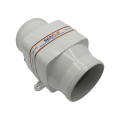Alex_Blackwood
Well-Known Member
Something else to go wrong when none of it was needed in the first place!12V Temperature Controller Switch with Probe 20A Thermostat Control -UK | eBay
I bought 3 of these to control fans, which I use to ventilate, the 5kVA inverter, housed under the nav table, the rectifier/inverter on the Whisper Power generator, and to provide additional airflow over the fridge compressor.
All these units are housed behind panels which don't allow a lot of ventilation. The fans extract air from the bilge and the hot air escapes through louvered vents.
They've been installed for over a year now, and are "fit and forget".
They have a temperature probe on about 700mm of wire, which I taped to an appropriate bit of the kit which gets hot.
You can use them to control heaters or cooling fans.
Setting them up was easy, because you can see the temperature at the probe.
And they are remarkable cheap.



